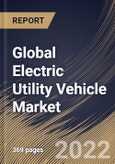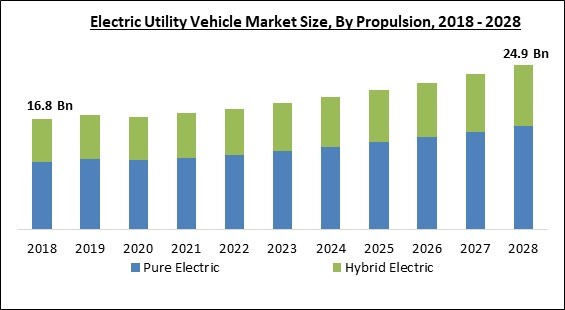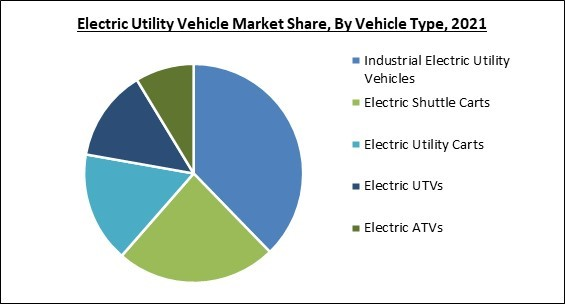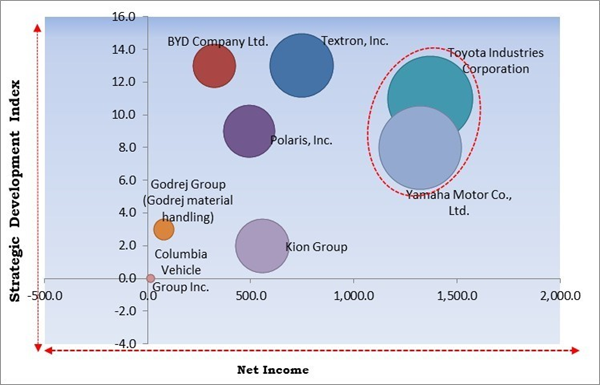The Global Electric Utility Vehicle Market size is expected to reach $24.9 billion by 2028, rising at a market growth of 5.3% CAGR during the forecast period.
Utility vehicle refers to a type of vehicle built to fulfill a certain duty and to traverse rugged terrain. Passenger and utility vehicles are used for commuting, with utility vehicles offering extra advantages over passenger cars, including increased passenger capacity, greater load-carrying capability, and enhanced safety and comfort, among others.
To meet operational needs, the majority of utility vehicles are designed with all-wheel drive (AWD) and four-wheel drive (4WD). Utility vehicles have a wide range of applications, including industrial activities, like the transportation of commodities, agricultural applications, and solutions for passenger transit. In recent years, electric utility cars have gained popularity due to their fuel-efficient operation and great noise reduction.
An electric vehicle is a type of vehicle that is operated by one or more electric motors. It can be fueled externally by a collector system or autonomously by a battery (sometimes charged with solar panels, or by converting fuel to electricity using fuel cells or a generator). EVs include surface and underwater watercraft, road and rail vehicles, electric airplanes, and electric spacecraft, among others.
EVs initially appeared a very long time ago, when electricity was one of the preferred ways for motor vehicle propulsion, offering a level of comfort and ease of operation that gasoline cars of the period could not match. In addition, internal combustion engines dominated the propulsion of automobiles and trucks, but electric power remained prevalent in trains as well as smaller vehicles of all sizes. Electric vehicles are either fueled by a collector system that collects electricity from charging station deployments or by self-charging equipment such as turbochargers, regenerative braking systems, and others.
The major strategies followed by the market participants are Partnerships. Based on the Analysis presented in the Cardinal matrix; Yamaha Motor Co., Ltd. and Toyota Industries Corporation are the forerunners in the Electric Utility Vehicle Market. Companies such as Textron, Inc., Polaris, Inc., BYD Company Ltd. are some of the key innovators in Electric Utility Vehicle Market.
The market research report covers the analysis of key stake holders of the market. Key companies profiled in the report include Textron, Inc., Polaris, Inc., Yamaha Motor Co., Ltd., Toyota Industries Corporation, BYD Company Ltd., Kion Group, Godrej Group (Godrej Material Handling), Columbia Vehicle Group Inc. (Nordic Group of Companies, Ltd.), Waev, Inc., and Addax Motors N.V.
Utility vehicle refers to a type of vehicle built to fulfill a certain duty and to traverse rugged terrain. Passenger and utility vehicles are used for commuting, with utility vehicles offering extra advantages over passenger cars, including increased passenger capacity, greater load-carrying capability, and enhanced safety and comfort, among others.
To meet operational needs, the majority of utility vehicles are designed with all-wheel drive (AWD) and four-wheel drive (4WD). Utility vehicles have a wide range of applications, including industrial activities, like the transportation of commodities, agricultural applications, and solutions for passenger transit. In recent years, electric utility cars have gained popularity due to their fuel-efficient operation and great noise reduction.
An electric vehicle is a type of vehicle that is operated by one or more electric motors. It can be fueled externally by a collector system or autonomously by a battery (sometimes charged with solar panels, or by converting fuel to electricity using fuel cells or a generator). EVs include surface and underwater watercraft, road and rail vehicles, electric airplanes, and electric spacecraft, among others.
EVs initially appeared a very long time ago, when electricity was one of the preferred ways for motor vehicle propulsion, offering a level of comfort and ease of operation that gasoline cars of the period could not match. In addition, internal combustion engines dominated the propulsion of automobiles and trucks, but electric power remained prevalent in trains as well as smaller vehicles of all sizes. Electric vehicles are either fueled by a collector system that collects electricity from charging station deployments or by self-charging equipment such as turbochargers, regenerative braking systems, and others.
COVID-19 Impact Analysis
Despite the fact that sales of electric vehicles were temporarily hampered by the pandemic, it is anticipated that the industry would therefore rebound with a higher growth rate than the previous year, due to the consistent increase in fuel prices and rising concerns about environmental pollution, as well as the provision of subsidies by various governments. The growth of the electric utility vehicle market was significantly hampered due to the pandemic; however, it is estimated to increase at a rapid pace as a result of the increasing efforts of governments all over the world to boost the automotive industry in their countries in addition to the growing adoption of electric vehicles due to their cost-effectiveness and environmental benefits.Market Growth Factors
An Increase In The Deployment Of Battery Switching Paradigm To Reduce Charging Time
Battery switching at the electric vehicle (EV) charging stations is the latest trend that eliminates the time electric utility vehicle users spend charging batteries. Although level 3 EV charging and ultra-fast charging can refuel an electric vehicle in 30-60 minutes and 15-30 minutes, respectively, they are not interoperable with electric utility vehicles. Consequently, battery changing is an excellent option for electric utility cars. In developed countries, various companies have deployed more than 300 battery switching stations in recent years and are significantly increasing their efforts in order to install more switching stations in the coming years.The Exponential Growth Of The Warehousing And Ecommerce Industry
The rising requirement to support the hub-and-spoke model in the e-commerce, automotive component manufacturing, consumer products, and electronics sectors is leading to an increase in the number of warehouses per country.in the coming years, the warehouse and fulfillment industry is anticipated to increase considerably, hence driving the demand for electric utility vehicles. Moreover, the increasing demand for industrial electric utility vehicles is anticipated to result from a rise in the number of warehouses. In turn, this will increase sales for the industrial segment of the electric utility vehicle market.Market Restraining Factors
The Significant Cost Of EUVs And The Presence Of Ice Counterparts
Users of utility vehicles often find it challenging to make the transition to more advanced electric versions of already existing models due to the additional high cost. Recent events in the market for electric utility vehicles have prompted original equipment manufacturers to increase the amount of money they invest in the development of products like these. This will result in an increase in the price of these vehicles because OEMs will want to recoup their investments. ATV model prices vary depending on feature requirements.Vehicle Type Outlook
On the basis of Vehicle Type, the Electric Utility Vehicle Market is segmented into Electric ATVs, Electric UTVs, Electric Utility Carts, Electric Shuttle Carts, and Industrial Electric Utility Vehicles. In 2021, the industrial electric utility vehicles segment acquired the largest revenue share of the electric utility vehicle market. There is extensive use of electric vehicles in the industrial sector. The combination of their high levels of performance, resilience, and autonomy makes them the ideal alternative for industrial applications, allowing significant cost reductions.Battery Type Outlook
Based on Battery Type, the Electric Utility Vehicle Market is segregated into Lead Acid, Lithium-Ion, and Others. In 2021, the lithium-ion segment registered the biggest revenue share of the electric utility vehicle market. A lithium-ion or Li-ion battery is a type of rechargeable battery that stores energy through the reversible reduction of lithium ions. It is the most common type of battery found in portable consumer devices and electric vehicles. It is also utilized extensively in grid-scale energy storage as well as military and aerospace applications.Drive Type Outlook
By Drive Type, the Electric Utility Vehicle Market is categorized into 2WD, 4WD, and AWD. In 2021, the AWD segment acquired a significant revenue share of the electric utility vehicle market. AWD electric vehicles are not particularly common in the automotive sector. Conventional vehicles with all-wheel drive are popular and widely utilized. All-wheel drive electric vehicle (AWD electric vehicle) refers to an electric vehicle whose front as well as rear wheels are interconnected to the electric motor. At low loads, AWD electric vehicles help to conserve energy.Application Outlook
On the basis of Application, the Electric Utility Vehicle Market segregated into Commercial Transport, Recreation, Agriculture, Industrial, and Others. In 2021, the industrial segment registered the largest revenue share of the electric utility vehicle market. Produced exclusively for businesses and individuals that want a high degree of quality, dependability, and performance. Additionally, a utility vehicle's ability to accomplish several activities and operate in a wide variety of conditions is a defining trait. Alkè electric utility cars are created following the preceding philosophy: excellence without exception.Seating Capacity Outlook
Based on seating capacity, the Electric Utility Vehicle Market is classified into 1-Seater, 2-Seater, and greater than 2-Seater. In 2021, the greater than 2-Seater recorded a substantial revenue share of the electric utility vehicle market. The rapid upsurge in the growth of this segment of the market is attributed to the increasing number of people going out for family adventure activities. This is a result of the rise in the disposable income of people across the world. Therefore, this factor is supporting the growth of this segment of the market.Propulsion Outlook
By Propulsion, the Electric Utility Vehicle Market is bifurcated into Pure Electric and Hybrid Electric. In 2021, the Hybrid Electric segment garnered a significant revenue share of the electric utility vehicle market. The growth of this segment of the market is increasing significantly due to the growing demand for this type of vehicle throughout developing countries due to their fragile charging infrastructure. The charging infrastructure among developing and under-developed countries are capable of supporting fully-electric vehicles, which is bolstering the growth of this segment of the market.Regional Outlook
Region-wise, the Electric Utility Vehicle Market is analyzed across North America, Europe, Asia-Pacific, and LAMEA. In 2021, North America accounted for the highest revenue share of the electric utility vehicle market. During the pandemic, the demand for electric ATVs/UTVs has increased dramatically in the region due to the rise in recreational activities, like camping, forest rides, hunting, etc. Moreover, there is also a significant prevalence of a number of market players in this region.The Cardinal Matrix - Electric Utility Vehicle Market Competition Analysis
The major strategies followed by the market participants are Partnerships. Based on the Analysis presented in the Cardinal matrix; Yamaha Motor Co., Ltd. and Toyota Industries Corporation are the forerunners in the Electric Utility Vehicle Market. Companies such as Textron, Inc., Polaris, Inc., BYD Company Ltd. are some of the key innovators in Electric Utility Vehicle Market.
The market research report covers the analysis of key stake holders of the market. Key companies profiled in the report include Textron, Inc., Polaris, Inc., Yamaha Motor Co., Ltd., Toyota Industries Corporation, BYD Company Ltd., Kion Group, Godrej Group (Godrej Material Handling), Columbia Vehicle Group Inc. (Nordic Group of Companies, Ltd.), Waev, Inc., and Addax Motors N.V.
Strategies Deployed in Electric Utility Vehicle Market
Partnerships, Collaborations and Agreements:
- Aug-2022: BYD joined hands with Castrol, a British oil company. Under this collaboration, the Castrol ON advanced EV fluids would be utilized in BYD’s growing range of electric vehicles. Additionally, with the ending of manufacturing of internal combustion engine (ICE) vehicles, Castrol would go towards supporting BYD boosting EV adoption around the world.
- Aug-2022: BYD came into a partnership with Orix, a Japanese diversified financial service. Through this partnership, the companies aimed to introduce the e6 electric vehicle within 5 cities in India, the first high-end electric, and the first and only variant to utilize the Blade Battery. Additionally, with the all-new e6, BYD is excited to begin the electric vehicle fleet procedure with the shared value of eco-friendly development.
- Jul-2022: Yamaha Motors formed a partnership with FullFily, an all-electric sustainable energy-powered EV vehicle business. Together, the companies aimed to utilize their’ strategic partnerships to enhance the access of fleet and infrastructure for tier 2/3 markets and the SMB space which is harshly under-serviced. Moreover, companies aimed to improve shared mobility utilization and develop employees.
- May-2022: BYD came into the partnership with Charge zone along with Volttic and Indipro. This partnership aimed to manage the re-charging requirements of the All-New e6.
- Mar-2022: BYD signed an agreement with Shell, a British multinational oil and gas company. This agreement aimed to enhance charging accessibility for battery electric vehicle (BEV) and plug-in hybrid electric vehicle (PHEV) owners. Moreover, companies would deliver combined home energy products including dynamic tariff scheduling, home batteries, solar integration, and Vehicle-to-Grid (V2G) charging.
- Mar-2022: Textron Ground Support Equipment joined hands with General Motors along with Powertrain Control Solutions. Through this collaboration, the GM and PCS have developed a combined driveline that leverages GM's lithium-ion battery systems. Moreover, Textron GSE would be capable to help from GM's experience in electric propulsion systems due to the driveline.
- Mar-2022: Textron entered into collaboration with General Motors company, engaged in manufacturing automobiles. This collaboration strengthened Textron's product portfolio. Working together with GE and Powertrain Control Solutions (PCS), the former company aims to deliver sustainable and highly efficient products and technologies for offering unmatched performance to customers.
- Feb-2022: Polaris came into a partnership with Wallbox, a smart electric vehicle charging, and energy management provider. Through this partnership, Polaris would sell the 40 Amp model of Wallbox's best-selling charger, the Pulsar Plus, in order to produce it even quicker for a consumer to charge their electric vehicles. Additionally, Off-road vehicles are a perfect fit for Pulsar Plus 40 Amp because of its NEMA connection, which presents greater versatility for agricultural and rural charging locations.
- Jan-2022: E-Z-GO, a Textron Specialized Vehicles business entered into a partnership with Rollick, the technology provider for the Marine, Powersports, and RV industries. Under the partnership, E-Z-GO uses RollickDR, Rollick's digital engagement module, to provide their customers with better buying experiences and to fulfill more online transactions.
- Dec-2021: Polaris introduced the Range XP KInetic, an all-electric vehicle. This launch is the result of the collaboration of Polaris and Zero Motorcycles. This vehicle has two times more torque and 35 percent more power as compared to other utilities side-by-side. The companies came into partnership in September 2020.
- May-2021: BYD teamed up with LEVO, a network for millennials in the workplace. Through this collaboration, the companies aimed to utilize Nuvve’s technology and stone peaks and grow capital via Levo to deliver fully invested, V2G-compatible BYD medium and heavy-duty electric fleet vehicles. Moreover, The BYD-Levo collaboration has the prospect to boost and develop the transportation industry at a crucial time.
- Mar-2021: Polaris signed a partnership with Optimus Ride, a provider of autonomous mobility services, to introduce fully autonomous and custom-designed GEM electric vehicles to the market. This partnership would advance the upcoming urban mobility, both in microtransit as well as in commercial markets. The companies are functioning together to promote the general adoption of autonomous GEM vehicles across the country and to bring safe, trusted, and fully autonomous rides into the everyday lives of people in cities, on campuses, and in communities for years to come.
- Jan-2021: BHP and Toyota Australia partnered on a new Light Electric Vehicle (LEV) trial at BHP’s Nickel West operations. Under the partnership, a LandCruiser70 has been converted from running on diesel to fully electric via onboard battery power. It is expected to fulfil several roles at site and operate in above ground and underground settings. BHP and Toyota have demonstrated a strong relationship throughout the last 20 years, and this project is a great testament to how we can both works together as leading companies in our respective industries to change the future. BHP Group Limited is an Australian multinational mining, metals, natural gas petroleum public company.
- Jan-2021: KION Group signed a partnership with BMZ Holding GmbH, developer and producer of high-tech battery systems. The partnership focuses on expanding the production capacity of lithium-ion batteries (LIBs) in Karlstein am Main with the help of its Joint Venture, KION Battery Systems (KBS). LIBs technology is majorly used in electric vehicles as they provide good high-temperature performance, increased power per mass battery unit, and high energy density.
Product Launches and Product Expansions:
- 2022-Oct: Toyota Motor Corporation introduced the Toyota bZ3, a battery electric sedan, the second model in its bZ Series. This model is the result of the collaboration of Toyota, BYD, and FAW Toyota.
- Oct-2022: Polaris launched Arctic MRZR and All-Electric RANGER XP, a fully-enclosed cab. The cabs are developed to be adapted to any Polaris MRZR Alpha version such as the wheeled or used with tracked kit version. Moreover, the cab delivers a quickly available solution that would contribute to fulfilling on-base sustainability conditions for zero emissions at a bit of the cost of full-size electric trucks.
- Oct-2022: BYD introduced BYD ATTO 3, a C-segment SUV, developed with the European consumer in mind. The BYD TANG is a 7-seater with varying all-wheel drive and the sleek and sporty sedan BYD HAN. Moreover, BYD has focused on dominating advanced technologies electronic control systems, electric motors, spanning batteries, and semiconductor chips.
- Apr-2022: Yamaha launched NEO and E01 electric scooters in India. The Yamaha NEO is a city commuter with a capacity of up to 68 kilometers whereas Yamaha E01 has a stated capacity of over 100 kilometers. Moreover, India is suitable as it would help from its well-known brand image since the only other main two-wheeler manufacturers with EVs are Bajaj and TVS.
- Jan-2022: Yamaha launched Yamaha EMF, unveiling a futuristic scooter. The EMF arrives with certain benefits such as a well-established network of battery swapping stations and a formed battery architecture, among other things. Additionally, EMF conveys a futuristic structure and specs with swappable batteries.
- Jan-2022: Toyota Materials Handling released 22 new electric industrial utility vehicles throughout all the environments and applications. Among them, 12 are truck models, launched with the power option of 24V, 36V, and 48V. These releases would expand Toyota's truck portfolio.
- Nov-2021: Godrej Lawkim Motors, a business segment of Godrej & Boyce Manufacturing Ltd., introduced electronic-switch (E-Switch) technology for its general-purpose motor’s lineup. This technology would be used instead of centrifugal switch technology for switching from main-winding to start-winding in single-phase motors.
- Apr-2021: Toyota Motor Corporation established a new series of battery electric vehicles (BEVs) Toyota bZ with the launch of Toyota bZ4X. Toyota bZ is based on BEV-dedicated platforms, which can be used with several variations with regard to design and size. The bZ4X contains a solar recharging system and combines a long wheelbase with a short overhang.
Acquisition, Joint Venture and Merger:
- Apr-2022: Textron completed the acquisition of Pipistrel, a Slovenia-based electric aircraft manufacturer. With this acquisition, Textron would further expand its product development and manufacturing abilities as Pipistrel joined Textron's new eAviation segment. Pipistrel will strengthen the production of light aircraft and gliders that are available in combustion as well as in electric engine formats.
Scope of the Study
By Vehicle Type
- Industrial Electric Utility Vehicles
- Electric Shuttle Carts
- Electric Utility Carts
- Electric UTVs
- Electric ATVs
By Propulsion
- Pure Electric
- Hybrid Electric
By Application
- Industrial
- Commercial Transport
- Recreation
- Agriculture
- Others
By Seating Capacity
- 2-Seater
- 1-Seater
- Greater Than 2 Seater
By Battery Type
- Lithium-Ion
- Lead Acid
- Others
By Drive Type
- 2WD
- 4WD
- AWD
By Geography
- North America
- US
- Canada
- Mexico
- Rest of North America
- Europe
- Germany
- UK
- France
- Russia
- Spain
- Italy
- Rest of Europe
- Asia Pacific
- China
- Japan
- India
- South Korea
- Singapore
- Malaysia
- Rest of Asia Pacific
- LAMEA
- Brazil
- Argentina
- UAE
- Saudi Arabia
- South Africa
- Nigeria
- Rest of LAMEA
Key Market Players
List of Companies Profiled in the Report:
- Textron, Inc.
- Polaris, Inc.
- Yamaha Motor Co., Ltd.
- Toyota Industries Corporation
- BYD Company Ltd.
- Kion Group
- Godrej Group (Godrej Material Handling)
- Columbia Vehicle Group Inc. (Nordic Group of Companies, Ltd.)
- Waev, Inc.
- Addax Motors N.V.
Unique Offerings
- Exhaustive coverage
- The highest number of Market tables and figures
- Subscription-based model available
- Guaranteed best price
- Assured post sales research support with 10% customization free
Table of Contents
Chapter 1. Market Scope & Methodology
Chapter 2. Market Overview
Chapter 3. Competition Analysis - Global
Chapter 4. Global Electric Utility Vehicle Market by Vehicle Type
Chapter 5. Global Electric Utility Vehicle Market by Propulsion
Chapter 6. Global Electric Utility Vehicle Market by Application
Chapter 7. Global Electric Utility Vehicle Market by Seating Capacity
Chapter 8. Global Electric Utility Vehicle Market by Battery Type
Chapter 9. Global Electric Utility Vehicle Market by Drive Type
Chapter 10. Global Electric Utility Vehicle Market by Region
Chapter 11. Company Profiles
Companies Mentioned
- Textron, Inc.
- Polaris, Inc.
- Yamaha Motor Co., Ltd.
- Toyota Industries Corporation
- BYD Company Ltd.
- Kion Group
- Godrej Group (Godrej Material Handling)
- Columbia Vehicle Group Inc. (Nordic Group of Companies, Ltd.)
- Waev, Inc.
- Addax Motors N.V.
Methodology

LOADING...











